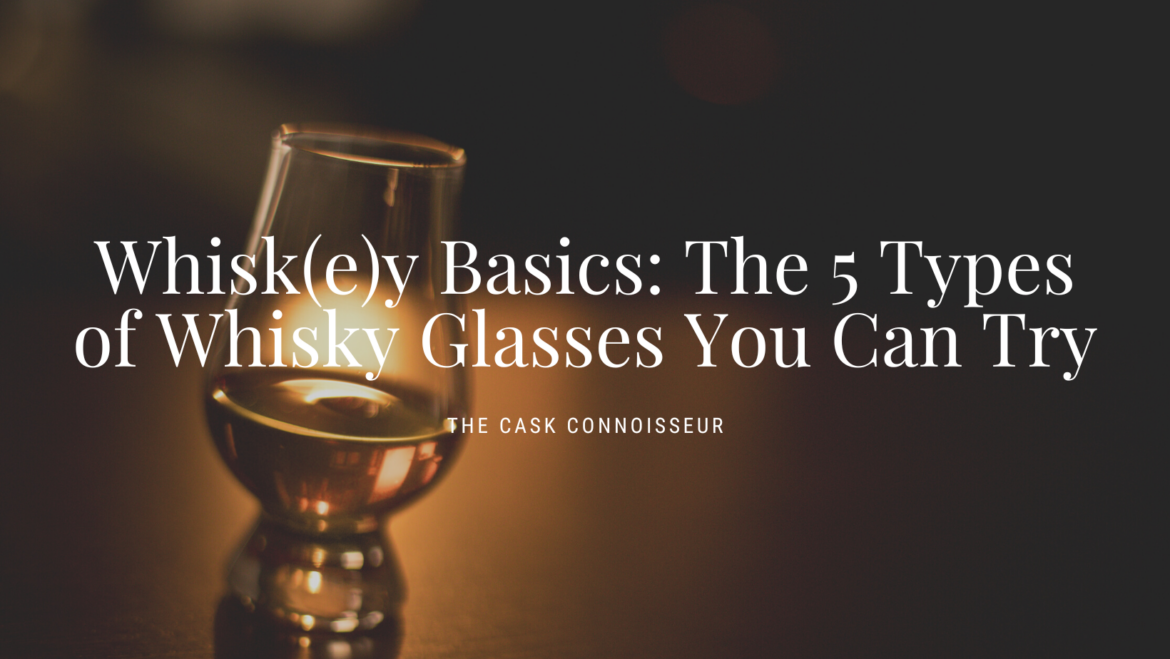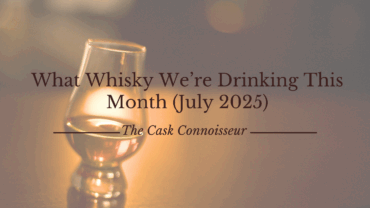Does the glass make a difference to the whisky drinking experience? Here are the top five glasses according to Chris Walster, our in-house whisky expert, you can use when it comes to drinking whisky.
Throughout this article, whisky includes whiskey. Why are there two names? Inclusion or not of “e” usually relates to the country of origin e.g. Irish whiskey is produced in Ireland. Confusingly, this can also indicate what the whisky was made from e.g. Rye whiskey, and has nothing to do with the country of origin. Does any of this matter? Probably not unless you’re part of a trade association and wish to protect “your product”. What is important is did you enjoy it?
Whisky, some 50 odd years ago, was reasonably simple, certainly for the majority of drinkers. You bought your favourite blend, drank it neat, with ice, water or soda from a whisky glass/tumbler. Occasionally you might buy a bottle of “10 or 12 year old malt” to celebrate, produced from one of a few distilleries, where production did not all go to blends. Other options were not widely available, with most coming from independent bottlers. The world of whisky we know today did not exist before the 1970’s, when it all started to change.
Today enjoying your favourite tipple can be as simple or as complex as you like, reasonably affordable or requiring a second mortgage. Here we try to demystify some of the issues new whisky drinkers might face. From what glass to use, what whisky to buy and how best you might enjoy it. Regardless of what you read here, how you drink your whisky is up to you. The purpose of the article is to provide some information that you may or may not choose to use. The only firm recommendation I’d make is please drink responsibly, any alcohol can and does cause health issues.
Glasses
Some 90% of “taste” comes from your eyes and nose, so your taste buds actually contribute very little to what you taste, they can be affected by what you’ve previously eaten, or what you’ve previously experienced, and finally by “suggestion”. I’m constantly amazed by how the number of flavours I can identify has increased/changed, by reading the tasting notes on the label or even discussing with your fellow drinkers. A glass provides both tactile (touch and weight) and visual enhancements that will likely elevate your experience of the whisky. The design of the glass will affect the nose, the whiskies temperature and ultimately the flavours.
Glencairn style
This is probably the most popular style of glass for whisky today (certainly in the UK), although surprisingly, it was only launched in 2001 by Glencairn Crystal. Rather like “hoover” becoming synonymous with the vacuum cleaner, “glencairn” is synonymous with this style of whisky glass. The design is based on the Copita glass which was originally designed to taste sherry and enhance the nose and palate.
It is a tulip shaped glass designed to hold 35 ml of whisky and allow the addition of water, with a solid base and no stem. Being easy to hold in the hand it is a popular glass to use at social events such as parties, whisky tastings and festivals.
This is my “go to” glass and certainly the crystal, cut glass version, enhances the colour of the whisky (as does any crystal glass) and is suitable for most whisky drinkers and whiskies. The tulip shape enhances the nose by concentrating the aromas. The shape and size of the glass also encourages you to swirl the whisky to visualise the legs and release the flavour profile.
As you travel along your whisky path, you will find that this glass is not ideal for all whiskies or whisky drinkers. You may prefer to hold a stemmed glass, it’s certainly not well designed to add ice or whisky stones to your drink. And it is not the ideal glass to ensure that the whisky is served at the correct temperature. An aspect along with allowing the whisky to breath which is frequently ignored by whisky drinkers, possibly because neither aspect is widely discussed or researched by “whisky specialists” and for many whiskies and the environment they are drunk in, may be not worth worrying too much about. However, you will notice that the flavours change the longer a whisky is in the glass due to exposure to air and any heat added by your hands. These issues are discussed more fully in our article on how to taste whisky.
Copita style
This is a style of glass with a tulip shape and a stem. It is particularly good at allowing you to experience the nose, firstly because it concentrates the aromas and secondly it keeps your hands well away from the rim of the glass. The theory being that this allows you to experience the nose of the spirit without potential contaminants from the hands such as natural oils and what you last handled affecting it. This attribute makes it popular with distillers, blenders and whisky connoisseurs.
A variation of a copita glass is one with a lid on it. The theory being the lid holds the volatiles released, concentrating them until you are ready to experience them. I use one occasionally if I want the whisky to warm up to room temperature. It appears to work but the lid is easily lost, and whisky does need contact with air, so I’m not convinced it is worthwhile.
I prefer using a copita glass when I wish to explore the flavour and aroma of a whisky. Something that is best done on ones own or in a small group. Because of the delicate feel the glass has, due to the stem, it’s not a party glass in my opinion.
Whisky Tumbler
There are numerous versions of this, and it is most likely the glass a whisky will be served in a pub or restaurant. With its wide neck allowing easy addition of ice and versatility of use I doubt it will ever be replaced. If it was the preferred whisky glass for James Bond, who am I to argue?
Norlan Whisky Glass
I’ve never tried this glass, but really like the idea of a scientifically designed whisky glass. First designed in 2015, the double wall of the original glass is meant to help prevent your hand from warming the whisky whilst holding and causing variations to its temperature. Whisky is best served at “room temperature”. Although what is room temperature, is my immediate thought? Changes in temperature will affect the nose and palate, so the glass will help achieve a more consistent experience.
The second innovation is the “scientifically performing” inside of the glass which it is claimed “delivers the aromatics and flavours to your senses”. This is done, as best I can see from the website at Norlan Glass, by dispersing the ethanol as it evaporates, decreasing any alcohol burn, and allowing your nose and palate to enjoy the whisky, whilst concentrating the aromatics and flavours.
What is clear, is this is a glass aimed at the premium market and is for those who wish to drink their whisky neat or maybe with a drop of water. Do not use it if you prefer ice or whisky stones in your glass.
I really do need to try these glasses and see if they live up to the expectation, but I would much prefer to be able to see, touch and feel them, before buying and unfortunately there is no retailer close to where I live. Interestingly in an email exchange with Norlan I was told the commonest reasons for returns were the glass is too light with a weight of approximately 125 grams, the mouth rim being too thick and the size being too small, with a recommended pour between 20-40ml (maximum volume approximately 175ml), which as I tend to go for 30ml when tasting sounds ideal.
On comparing the above measurements to other whisky glasses, the weight is on the light side but identical to one I frequently use. Although if you enjoy the weight of a crystal glass (approximately 100-125 grams heavier), it probably is too light for you. On the mouth rim there is no choice but to try and that will come down to personal preference. I suspect in the end curiosity will get the better of me and despite reservations over the touch and feel of the glass in my hand, Norlan will become part of my whisky adventure.
Other Glasses
Let’s face it, whisky can be drunk out of any receptacle, it’s just that some glasses are possibly more useful or perform better in certain circumstances. A Highball glass, tall and straight is great for whisky cocktails, a brandy glass has many of the attributes of the above glasses and is a pretty good substitute.
One tip though that you should always try to follow is, rinse and dry your glass out between different whiskies or reach for another glass. Whisky is very sensitive to small amounts of “contaminants” ; even one drop of water can significantly change the nose, palate, and finish of a whisky. Think what all those flavours in that minute drop of the previous whisky might do. Not following this rule is unlikely to ruin your evening, but I can assure you from experience that every once in a while, the effect can be pretty dramatic and certainly will ruin that one whisky.






2Comments
March 12, 2023 at 11:08 am
April 2, 2023 at 9:40 am